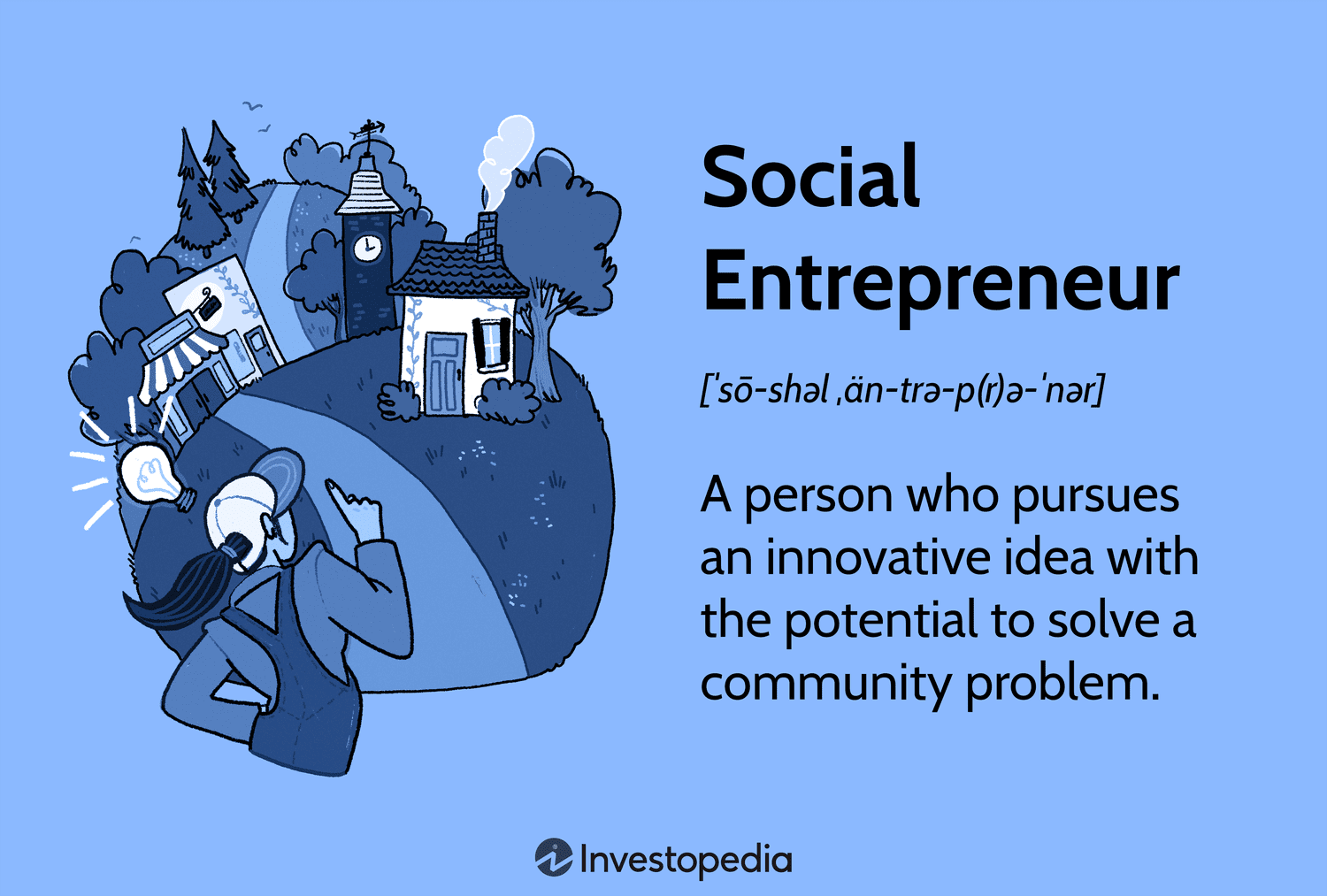Understanding Social Entrepreneurship: Bridging Profit and Purpose
Social entrepreneurship is an innovative approach to addressing societal challenges while generating sustainable economic value. This dual focus on social impact and profitability sets social entrepreneurs apart from traditional business owners. In this article, we will delve into the essence of social entrepreneurship, its significance in today’s world, key strategies for success, and real-world examples that highlight its transformative potential.
:max_bytes(150000):strip_icc()/social-entrepreneur.asp-final-4ac86e3c90124f4aa484e352820ee61e.png)
What is Social Entrepreneurship?
Definition and Key Characteristics
At its core, social entrepreneurship combines the mission of social change with innovative business strategies. According to the Skoll Foundation, social entrepreneurs are driven by a desire to solve complex social issues, creating solutions that are sustainable, scalable, and impactful.
Key characteristics of social entrepreneurship include:
- Mission-driven: Unlike traditional businesses, the primary goal is to address social, cultural, or environmental issues.
- Innovative: Social entrepreneurs often use unconventional methods and ideas to create change.
- Sustainable: They focus on building a self-sustaining business model that allows them to continue their social missions without relying solely on donations or grants.
Difference Between Social Entrepreneurship and Traditional Entrepreneurship
While both social and traditional entrepreneurs aim to create value, their core motivations differ significantly:
- Profit vs. Purpose: Traditional entrepreneurs primarily seek profit, whereas social entrepreneurs prioritize societal impact alongside profitability.
- Measurement of Success: Traditional businesses measure success by financial metrics, while social enterprises assess their impact through social indicators such as community improvement, environmental sustainability, and overall welfare.
Importance of Social Entrepreneurship
Social entrepreneurship plays a vital role in today’s society for several reasons:
Addressing Social Issues
Social entrepreneurs tackle pressing challenges such as poverty, education, healthcare, and environmental sustainability. They create innovative solutions that improve the quality of life for marginalized communities. For instance, organizations like Kiva provide microloans to entrepreneurs in developing countries, helping them lift themselves out of poverty.
Creating Sustainable Solutions
Sustainability is a cornerstone of social entrepreneurship. By focusing on long-term solutions rather than short-term fixes, social enterprises ensure that their positive impact endures over time. This can lead to systemic change within communities, transforming how social issues are addressed.
Economic Impact and Job Creation
Social enterprises also contribute to the economy by generating jobs and stimulating local economies. As these businesses grow, they create opportunities for employment, which can uplift entire communities. According to a report by the Global Impact Investing Network, impact investments are projected to reach $1 trillion by 2025, demonstrating the economic potential of social enterprises.
Key Strategies for Social Entrepreneurs
To thrive in the competitive landscape of social entrepreneurship, aspiring social entrepreneurs should consider the following strategies:
Identifying a Social Problem
The first step in building a successful social enterprise is to identify a specific social problem that resonates with the entrepreneur’s values and expertise. This involves thorough research and engagement with the community to understand their needs.
Developing a Sustainable Business Model
Creating a viable business model is crucial. Social entrepreneurs must balance their social missions with the need for financial sustainability. This often involves exploring various revenue streams, such as product sales, service fees, or partnerships with larger organizations.
Measuring Impact and Success
To assess the effectiveness of their initiatives, social entrepreneurs should implement robust metrics to measure their impact. This can include surveys, data analysis, and community feedback. By demonstrating measurable outcomes, social enterprises can attract funding and support from investors, stakeholders, and the community.

Challenges Faced by Social Entrepreneurs
Despite the promise of social entrepreneurship, several challenges can impede progress:
Funding and Financial Sustainability
Securing adequate funding can be a significant hurdle for social entrepreneurs. Unlike traditional businesses, they often rely on a combination of grants, donations, and impact investments. Navigating these funding sources can be complex, requiring entrepreneurs to develop compelling business cases and demonstrate their impact.
Balancing Social Mission and Financial Goals
Social entrepreneurs must find a balance between their mission and the need for financial viability. This often leads to difficult decisions, such as whether to prioritize profit margins or community impact.
Navigating Regulatory Challenges
The regulatory landscape can be daunting for social enterprises, as they often operate in sectors that require compliance with various laws and regulations. Understanding these requirements is essential to avoid legal issues and ensure smooth operations.
In the second half of the article, we will explore real-world examples of successful social enterprises and discuss the future of social entrepreneurship. Stay tuned to discover how innovative minds are pioneering change in today’s world.
Real-World Examples of Successful Social Enterprises
To better understand how social entrepreneurship drives meaningful change, let’s look at some notable examples of successful social enterprises that have made a profound impact across various sectors.
1. TOMS Shoes: The “One for One” Model
One of the most recognized social enterprises globally, TOMS Shoes, operates on a unique business model where, for every pair of shoes purchased, a new pair is donated to a child in need. This “One for One” model has revolutionized the way businesses approach philanthropy, combining consumerism with social impact. Since its inception, TOMS has expanded this model to provide eyewear, water, safe birth services, and bullying prevention programs, proving that businesses can successfully balance profit and purpose.
“When you incorporate giving into your business model, it changes the entire relationship with your customers. It creates an emotional connection that extends far beyond the product.” – Blake Mycoskie, Founder of TOMS
2. Grameen Bank: Empowering Communities Through Microfinance
Founded by Nobel laureate Muhammad Yunus, Grameen Bank is a prime example of how social entrepreneurship can tackle financial inequality. By offering microloans to underserved communities, particularly women in developing countries, Grameen Bank has enabled countless individuals to start their own businesses, escape poverty, and improve their quality of life.
The success of this model has inspired numerous other microfinance institutions worldwide. Yunus’s vision demonstrates how small financial interventions can empower marginalized groups and spark large-scale social and economic change.

3. Patagonia: A Commitment to Environmental Sustainability
Patagonia, the outdoor apparel company, is not just known for its high-quality products but also for its unwavering commitment to environmental sustainability. The company pledges 1% of its sales to environmental causes and encourages customers to repair, reuse, and recycle their gear. In 2018, Patagonia announced that the company’s entire $10 million Black Friday sales would be donated to environmental groups.
Patagonia exemplifies how social entrepreneurship can intersect with environmental stewardship, showing that profit and environmental protection are not mutually exclusive.
The Future of Social Entrepreneurship
As the world becomes more aware of social and environmental issues, social entrepreneurship is expected to play an even greater role in shaping the future of business. Here are some trends to watch:
1. Increased Focus on Sustainability
Sustainability will remain a crucial focus for social entrepreneurs. With growing concerns over climate change, resource depletion, and ecological degradation, businesses will be expected to innovate around sustainable practices. The transition toward circular economies, where resources are reused and waste is minimized, will be key to future business models.
2. Tech-Driven Social Solutions
Advances in technology, including AI, blockchain, and the Internet of Things (IoT), will empower social entrepreneurs to create more efficient, scalable solutions. For example, blockchain can be used to ensure transparency in supply chains, while IoT devices can help track the impact of environmental projects in real-time. Tech will allow social enterprises to scale their impact more rapidly than ever before.

3. Impact Investment on the Rise
According to the Global Impact Investing Network, impact investing has seen exponential growth, with billions being funneled into companies that prioritize social and environmental objectives. As investors increasingly seek to align their portfolios with their values, social enterprises will have access to more capital to scale their operations and deepen their impact.
Frequently Asked Questions (FAQs)
What is the difference between a social enterprise and a non-profit organization?
A social enterprise is a business that prioritizes social impact while also generating profits. In contrast, a non-profit organization typically relies on donations and grants to sustain its operations. Social enterprises reinvest their profits into their mission, while non-profits often operate on a zero-profit basis.
How do social entrepreneurs measure success?
Success in social entrepreneurship is measured by social impact metrics rather than solely financial returns. These metrics can include the number of lives improved, reduction in environmental damage, or contributions to social equity. Financial sustainability is important but secondary to mission-driven goals.
What are the funding options for social entrepreneurs?
Social entrepreneurs can access various funding sources, including:
- Impact investors who prioritize both financial returns and social impact.
- Crowdfunding platforms like Kickstarter and Indiegogo.
- Grants from governmental or non-governmental organizations that support social causes.
- Traditional financing, such as venture capital, where investors see long-term potential in the business model.
Can social enterprises be profitable?
Absolutely. While the primary focus of a social enterprise is social impact, many of these businesses are highly profitable. They achieve success by identifying market opportunities that align with social needs, and then delivering innovative solutions that customers are willing to pay for.
In conclusion, social entrepreneurship is about more than just doing good—it’s about building sustainable solutions that address global challenges while creating economic value. As more businesses recognize the power of social impact, we can expect to see an even greater integration of purpose-driven innovation across industries, leading to a future where profit and purpose coexist harmoniously.


